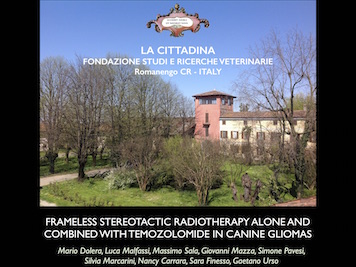FRAMELESS STEREOTACTIC RADIOTHERAPY ALONE AND COMBINED WITH TEMOZOLOMIDE IN CANINE GLIOMAS
Brain gliomas are diagnosed in an increased number of dogs. Few data regarding the best treatment regimen are available. The primary aim of this work was to evaluate the feasibility and efficacy of high dose hypo fractionated volume modulated arc radiotherapy (VMAT RT) in canine gliomas. The secondary aim was to assess the efficacy and toxicity of combination of radiotherapy with temozolomide.
72 client owned dogs with imaging based or histologically confirmed diagnosis of brain gliomas were enrolled. LINAC based frameless stereotactic radiotherapy was offered to all dogs. Dogs whose owners refused RT were palliatively treated (palliation arm). The schedule of treatment has ranged between 33 Gy/5 fx and 42 Gy/10 fx according the volumetric dose constraints of the brain (RT arm). During the second phase of the study, the same RT treatment was offered combined with temozolomide (TMZ) 65 mg/m2 orally administered 6 hours prior each fraction and then for 5 days monthly for 6 cycles (RT+TMZ arm). Regular clinical examinations were performed during and after irradiation time, with regard to mentation, deambulation, cranial nerve dysfunction and seizures. Serial magnetic resonance imaging exams were done 2, 4, 6, 12, 18, 24 months after irradiation. Volumetric disease response and imaging findings were implemented with clinical neurological systematic evaluation to assess the course of the disease. Multivariate analysis to assess any prognostic significance was performed. Overall and disease specific survival were estimated using the Kaplan Meier curves.
30 dogs were palliated, 22 dogs were treated with RT, 20 were treated with RT+TMZ. Among RT arm, 7 dogs were treated with 42 Gy/10 fx, 15 dogs with 35 Gy/5 fx. Among the RT+TMZ arm, 10 dogs were treated with 42 Gy/10 fx, 2 dogs with 38 Gy/5 fx, 4 dogs with 35 Gy/5 fx, 4 dogs with 33 Gy/5 fx. 1 grade II radiotoxicity was observed. Median overall survival in palliated, RT and RT+TMZ arm was 94 days, 383 days, 420 days. 11/42 dogs have died from the brain tumor, 8/11 due to recurrent disease within the irradiation field, 3 due to spinal seeding. No statistically significant difference in survival was evident for the different grade of tumors (GII-GIII p=0.10; GIII-GIV p=0.68), presence of oedema, mass effect and between RT and RT+TMZ (p=0.61), whereas RT and RT+TMX were different from palliated (p=0.00089; p=0.000061). The statistically significant prognostic factors were the relative volume of the tumor <5% (p=0.013) and the clinical presentation with no alteration mental status (p=0.032).
VMAT RT is feasible and effective for canine brain gliomas. Small tumors and normal mental status are positive prognostic factors. The combination with TMZ at the used dose don’t elicited any additional improvement in survival rate. Dose escalation in TMZ combination could be evaluated in further research.
